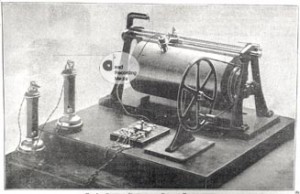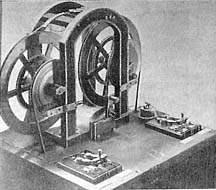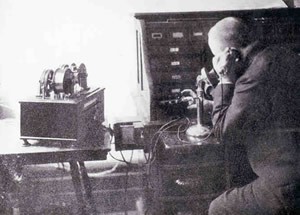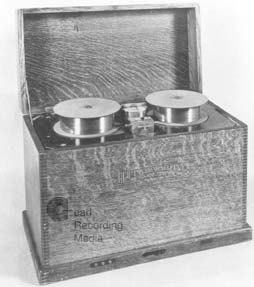The first practical form of “magnetic” recording (that is, the kind of recording process used with videotape, audio tape, computer hard drives, etc.) came in the form of sound recording on steel wire. Between about 1898 and 1900, Danish inventor Valdemar Poulsen developed and patented the “Telegraphone,” the first commercial wire recorder.
The Telegraphone (pronounced with the emphasis on the second syllable) was the first device capable of recording sound magnetically, and it did so on a thin steel wire; Poulsen and others called it piano wire, and it was apparently a single strand of commercially available wire made of ordinary steel. His very first machine, intended only to demonstrate the concept, employed a relatively short length of wire, wrapped around a metal cylinder, which was hand-cranked.

An early Poulsen Telegraphone
This simple design avoided the need to design a functional wire-transport system for handling long lengths of wire or regulating the speed of the wire–both critical considerations. Within a short time, Poulsen also demonstrated a steel “ribbon” or tape recorder and then a machine to record magnetically on a steel disk. These had more elaborate mechanical designs and were promoted as practical solutions to business needs.

Steel-tape Telegraphone
All three types were promoted as alternatives to phonograph-type dictating machines, such as the recently introduced phonograph and graphophone (in the 1880s these were still sold mainly for dictation). Poulsen saw as the chief advantage of the Telegraphone its ability to record directly from the telephone lines, which the phonograph could not do. Such a machine might, for example, provide a sort of remote dictation capability. It was a humble beginning for a technology that would eventually replace its rival, the phonograph, and become amazingly common today.

Man dictating a business letter using one of Poulsen’s later wire-type Telegraphones.

A wire-type Telegraphone made by the American Telegraphone Co.
The Telegraphone generated a lot of excitement and was hailed as a scientific breakthrough (the recording process seemed to contradict contemporary theories of magnets). As a commercial product, the history of the Telegraphone was less than spectacular. It was manufactured in at least two versions, one by Poulsen’s workers in Denmark, and another by the American Telegraphone Company of Wheeling, West Virginia and later Springfield, Massachusetts.